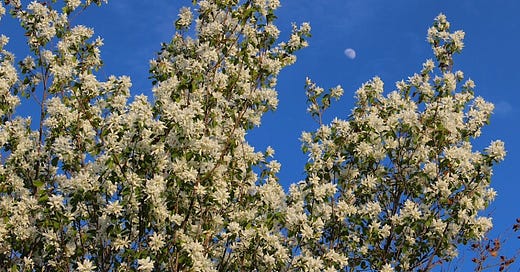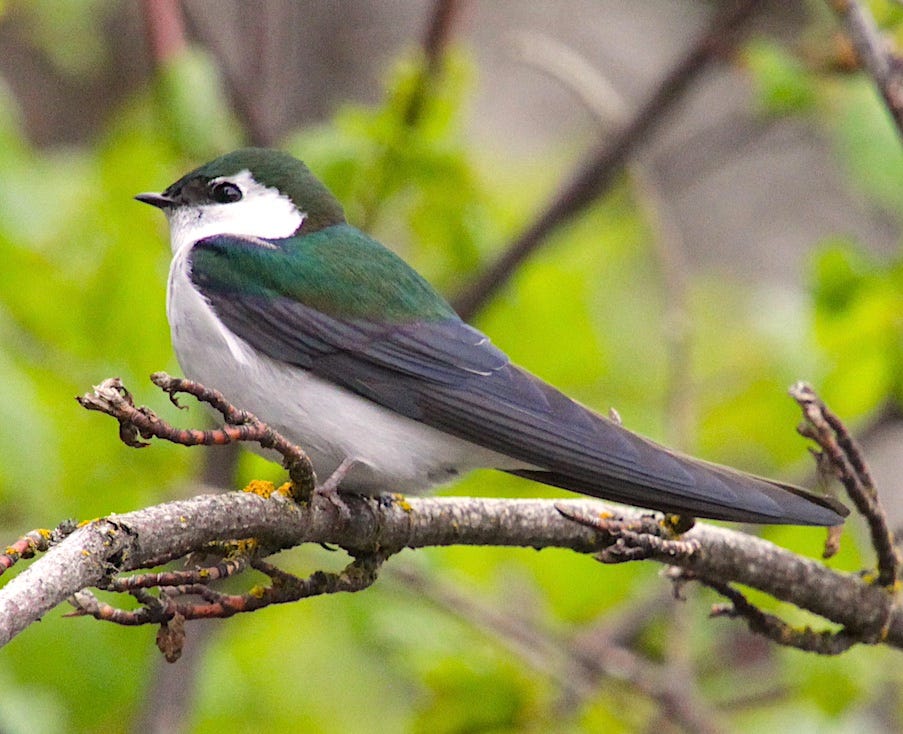Moon in the serviceberry
It won’t surprise you to read that one of the reasons, perhaps the main reason, I launched The Daily Rhubarb is to write timely pieces about the events and ideas that pique my interest. It may seem that I’m all over the lot: one day musing about landscapes or creatures I’m drawn to photograph, the next day trying to untangle a gnarly legal issue; the next day pulled in by gravitational waves. I get to assign myself and consider myself blessed to live in a country (as teetering as it is, presently) where writers only rarely get jailed and shot at for their work.
Today I’m going to show, and write a bit about the Violet-green Swallow, a vibrant, elusive subject, every bit a signal of spring as crocuses and the pounding, vernal run-off at the Spokane Falls just down the street a bit. Here’s a photo of the colorful, bat-like swallow from days ago, snapped from a rather precarious perch in the river gorge (please don’t tell my children.)
Male Violet-green Swallow, cutting a tight turn against the rimrock in Tuesday’s sunshine
The night before I took the photo I experienced what, for me, was a first as a journalist: I attended a public meeting at a casino. It was at Northern Quest out at Airway Heights, in a medium-sized ballroom where 70-80 people gathered to ask questions and hear from several public officials from local, state and federal agencies.
The West Plains has water issues. While the City of Spokane is blessed with a fast-flowing aquifer in glacial cobbles fed by rain and snowmelt in the Idaho panhandle, Airway Heights and the West Plains sit above all that.
Historically, Airway Heights and surrounding communities and private land holders have drawn water from wells drilled into the tangle of seams and channels in the deep basalt layers that dominate the landscape. The problem is that much of this groundwater water is now contaminated with hazardous chemicals that have seeped from two airports —Fairchild Air Force Base and what is now Spokane International Airport. It is a serious problem and one that has forced both Fairchild and the City of Airway Heights to pipe in drinking water from the City of Spokane.
This is a big story, not just locally but internationally as it involves a widely-used family of “forever” chemicals with pernicious physical and toxic qualities. We all have traces of in our bloodstream, but some of us have much higher concentrations than others, and contaminated drinking water is a major cause. For a quick and informative overview I’ll recommend this recent Vox podcast featuring Barbara Moran, WBUR’s environment and climate reporter. Barbara refers to drinking water as the “big enchilada” of the widespread contamination problem which she has covered in Massachusetts for years.
Fairchild was placed on the federal CERCLA (Superfund) cleanup list thirty years ago after benzene and a common solvent, trichloroethylene (TCE) were found in groundwater on base.
Not to downplay the TCE problem, but it has been eclipsed by the startling discovery—six years ago this month—that groundwater on the West Plains contains high levels of perfluorooctanoic acid (PFOA) and perfluorooctane sulfonic acid (PFOS) The compounds (of which there are thousands of variants) are commonly referred to as PFAS, and more colloquially as “forever chemicals.”
PFAS are extremely long-lived endocrine disrupters—once we consume them they can interfere with the ornate communication system our bodies use to regulate our growth and metabolism through hormones. Ingesting PFAS is not a death sentence, but health science indicates exposures increase our risk to a variety of adverse health outcomes—cancer among them.
Because of their almost magical properties (i.e. the non-stick attribute of teflon in cookware, stain-resistant carpets, waterproof cosmetics) PFAS found their ways into millions of consumer products dating back at least to the 1960s. One product that emerged in response to tragic aviation accidents, such as the 1967 fire aboard the USS Forrestal in 1967, is what is known as aqueous film-forming foam, (AFFF) which is: a) much more effective than water at quelling petroleum fires, and b) loaded with PFOA. In short, AFFF was used for decades at Fairchild both on actual aviation fires and for countless firefighter training exercises. It moves easily into and through groundwater.
While Airway Heights and Fairchild are now on Spokane water, that’s not the case with the many residents of the West Plains in unincorporated areas who rely on wells for tap water and irrigation. That explains the turnout, Monday, at Northern Quest. Some have received Air Force help to remove PFAS from their drinking water, but not everybody, and some—many miles from the base—have had to dig into their own pockets after their tap water tested positive for PFOA.
This makes for a long story and today’s mention of it is both to preview the story and reveal a bit more about my editorial approach. One reason to report on the West Plains contamination story is that I’ve written extensively about the complex contamination and groundwater problem at Hanford, beginning with the 1986 in-depth report Hot Water that fed into my subsequent Congressional testimony on the Hanford radioactive waste problem. In 1997 I authored a book, Burdens of Proof, that looks at the tools and limitations of public health studies in situations very much like the current West Plains case.
These are complex stories, and generally not happy ones. Some of the testimonials I heard Monday night from the audience are distressing, about the deaths of people and pets who drank the water before the evidence of contamination came to light, or at least was made known to them.
This is life as we know it and I don’t want to shy away from it. But I’m also working to finding the right balance. It is not the purpose of The Daily Rhubarb to become the “Daily Oh-My-God!”
I’d rather be the neighbor who helps with your compost than the one making sure you aren’t missing out on the latest outrage. Which is not to dismiss the importance of outrage. I just think a constructive outrage is most likely to arise from a healthy heart and soul, eyes open and rooted in the wonder of life. Anger breeds righteousness, which is too easily a gateway drug to a vengeful, closed-mind and bitter soul.
On that note, it’s impossible to ignore the welcome news of spring. Which brings me back to the Violet-green Swallow. Late April is a big deal, especially in a four-season city like Spokane where winter can be both beautiful and harsh, with long nights, gaping potholes, spinning tires, falls on ice; not to mention frozen pipes.
Beneath my hiking shoes in recent days I’ve noticed not just the early bursts of grass widows, shooting star, balsamroot, among other wildflowers but staples such as lomatium shooting up and into bloom. Some favorite birds have come back, though most are still taking their times. I’ve yet to see or hear a warbler, for example.
It’s hard to miss the swallows though and, on the rimrock cliffs I favor, the first to return are the incredibly acrobatic Violet-green Swallows that spend their winters as far south as Nicaragua before returning in early spring.
A couple more photos. The males wear the vibrant green.
—tjc
Female swallow at perch on the ledge
Male at perch on a streamside limb








